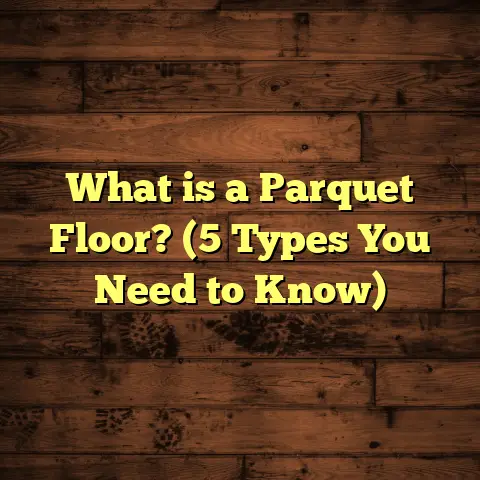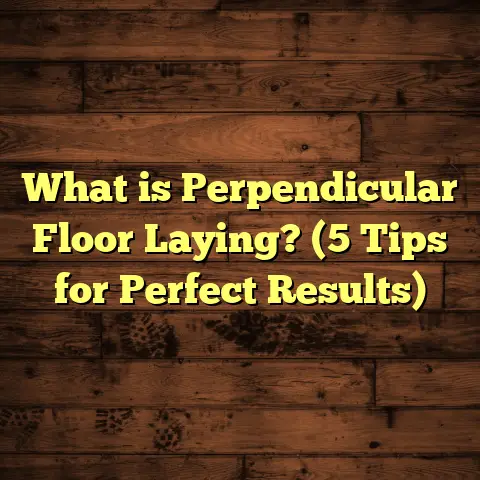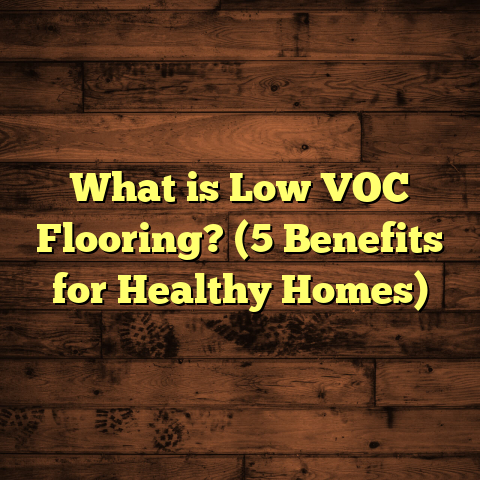What is WPC Floors? (5 Key Benefits for Modern Homes)
Accessibility is a big deal when picking out flooring. Over the years, I’ve worked in homes where people wanted floors that not only look great but are easy to live with. That means floors that don’t require fancy upkeep or special treatments, and that stand up to real-life messes and moisture without falling apart. WPC flooring has become one of those go-to products for me because it hits all those marks.
I first came across WPC flooring about five years ago when a client wanted something that could handle the humid climate but still feel warm and inviting. Since then, I’ve installed it in kitchens, basements, bathrooms, and even commercial spaces. Every time, it’s been a reliable, stylish choice that adapts well.
Let me take you through what WPC flooring is all about, how it’s made, why it works so well in modern homes, and how to care for it properly. Along the way, I’ll share stories from the field, insights from research, and some stats that might surprise you.
What is WPC Flooring?
You’ve probably heard the term “WPC” tossed around in flooring stores or online forums. What does it really mean? At its core, WPC stands for Wood Plastic Composite. It’s a material made by mixing wood fibers (or sometimes sawdust) with plastic polymers—usually PVC (polyvinyl chloride). This mix creates a dense, solid plank that looks like wood but has some very different properties.
Think about what happens when you combine wood with plastic: you get the natural look and feel of wood but with added resistance to water, dents, and temperature changes. That’s the magic behind WPC floors.
How WPC Flooring is Made
The manufacturing process is pretty interesting. The wood fibers and plastic are combined under heat and pressure to form a core board. This core is the thickest part of the plank and gives it strength and rigidity.
On top of this core comes the decorative layer. This is usually a high-definition film printed with realistic wood grain patterns—oak, walnut, hickory, you name it. Advances in printing technology mean these patterns can look so close to real wood that you’d have to touch the surface or inspect it closely to tell the difference.
The last layer is a transparent wear layer made of urethane or aluminum oxide. This protects the decorative layer from scratches, scuffs, stains, and UV rays that cause fading.
Why Call It Luxury Vinyl Flooring?
WPC floors fall under the broad category of luxury vinyl flooring (LVP), but their core is thicker and more rigid compared to traditional vinyl planks or tiles. While vinyl flooring itself is thin and flexible, WPC’s composite core gives it a sturdier feel underfoot.
This makes WPC a popular choice for people who want vinyl’s durability but dislike how cheap or hollow some vinyl floors feel.
How Does WPC Compare to SPC Flooring?
You might also come across SPC flooring—Stone Plastic Composite—which uses limestone instead of wood fibers mixed with plastic. SPC tends to be even harder and more rigid than WPC but can feel colder underfoot.
I usually recommend WPC for residential areas where warmth and comfort matter more, while SPC gets favored in commercial or industrial settings where extreme durability is needed.
My Personal Experience With WPC Floors
I recall working on a kitchen remodel for a family with two young kids. They wanted floors that could handle spills, dropped toys, and high traffic but also look warm and inviting like wood. After showing them samples of hardwood, laminate, vinyl, and WPC, they chose WPC.
The installation was quick—done in just two days—and since then, the floors have held up beautifully against stains and scratches. The kids loved the slightly cushioned feel when playing on the floor, which was something they hadn’t experienced with tile or hardwood before.
Why Are WPC Floors Becoming Popular in Modern Homes?
I’ve noticed a steady rise in demand for WPC floors over the past several years. Homeowners are drawn to their blend of beauty and practicality. But what exactly makes them such an attractive option? Here are five key benefits I’ve observed and documented through projects and research.
1. Water Resistance That Works
Water damage is one of the biggest concerns when choosing flooring for kitchens, bathrooms, or basements. Hardwood can swell or warp with moisture exposure; laminate can peel or bubble; traditional vinyl can lift at edges.
WPC floors address these issues with their waterproof core.
How waterproof are they really?
Laboratory tests show WPC floors have water absorption rates as low as 0.05%, compared to hardwood’s several percent absorption rate. This means water sits on the surface instead of soaking in.
In practical terms, this translates to:
- No warping after spills or drops
- Ability to install in moisture-prone areas like bathrooms
- Resistance to mold and mildew growth beneath the floor
A homeowner I worked with in Florida told me after installing WPC floors in her bathroom that she no longer worries about water pooling near the shower or sink. The floor remains flawless despite daily moisture exposure.
2. Easy Installation Saves Time and Money
One thing I love about WPC floors is how quick and simple they are to install. The click-lock system means you don’t need glue or nails; the planks snap together like puzzle pieces.
On average, installing WPC floors takes 30-50% less time than traditional hardwood or tile installations. That saves money on labor costs and means less disruption at home.
In one project with tight deadlines—a small retail store—the entire floor was installed in under two days by a two-person crew. The floating installation method also means less mess and no drying time for adhesives.
For DIYers, this straightforward method is a major plus. Many homeowners have successfully installed WPC floors themselves after watching some tutorial videos and reading manufacturer instructions.
3. Durability Meets Comfort
Durability matters for any flooring material—but comfort counts too. Hard floors can be tough on feet and joints, especially if you spend long periods standing in one spot.
WPC floors offer a slight cushion because of their composite core which absorbs impact better than laminate or tile.
Scratch resistance is another benefit. Thanks to the thick wear layer (often 20 mils or more), WPC floors resist scratches from pets’ nails and furniture moving around.
In fact, wear layers above 12 mils are considered very durable for residential use; many WPC products exceed this standard.
I’ve visited homes where pets roam freely on WPC floors and noticed minimal signs of wear even after years of use.
4. Realistic Look Without the Hassle
If you’re like me, you want your floors to look authentic without spending hours maintaining them. Wood floors bring warmth to any room but require refinishing every few years—something many homeowners don’t want to deal with.
WPC floors give you that wood look without sanding or sealing. The printed layer is resistant to fading and stains so your floor maintains its beauty over time.
Manufacturers now offer dozens of wood finishes—from distressed farmhouse oak to sleek dark walnut—that capture wood’s natural texture and grain.
One client told me they couldn’t believe their new WPC floor looked so much like real hardwood that guests kept asking if they had refinished their old floors!
5. Sound Insulation and Warmth
Hard surfaces tend to echo footsteps loudly—especially tiles or laminate over concrete slabs—which can be annoying in multi-level homes or apartments.
WPC’s thicker core acts as an insulator for sound, reducing noise transmission between rooms or floors below.
In addition to sound benefits, it also feels warmer underfoot compared to stone or tile because of this cushioning effect.
In one condo renovation I handled recently, the owner complimented how much quieter their unit felt after swapping out laminate for WPC flooring throughout.
Practical Guide: Installing WPC Floors Right
Let me share some tips based on my experience installing WPC flooring in dozens of homes:
Subfloor Prep Matters
Before installation begins, your subfloor needs to be clean, dry, flat, and free of debris.
WPC floors can be installed over:
- Concrete slabs (with vapor barriers)
- Plywood or OSB subfloors
- Existing vinyl flooring (if flat)
Uneven subfloors cause locking problems or uneven wear later on. If your surface isn’t flat within 3/16 inch per 10 feet, you might need leveling compounds.
I always recommend testing moisture levels in concrete slabs before installation since excess moisture can damage any floor over time—even waterproof types if water sits below.
Acclimation Helps Stability
Allowing the planks to acclimate to your home’s temperature before installation helps prevent expansion issues later on.
Typically 48 hours at room temperature is enough for them to adjust properly.
Leave Expansion Gaps
Because WPC floors expand and contract slightly with temperature changes—even if less than wood—you must leave an expansion gap around edges (about 1/4 inch).
This gap is covered later by baseboards or molding but prevents buckling if the planks swell during hot weather.
Floating Installation Means Flexibility
Since these floors float above the subfloor (not glued down), cleanup is easier and you can walk on them immediately after installation.
Plus, if any plank gets damaged down the road—say from a dropped heavy object—you can remove just that piece without ripping up the whole floor.
Maintenance Tips That Keep Your Floors Looking New
Keeping your WPC floor looking fresh doesn’t take much effort:
- Sweep or vacuum regularly to remove dirt that can scratch surfaces
- Mop occasionally with a damp mop using cleaners recommended by your manufacturer (usually mild soap solutions)
- Avoid harsh chemicals like bleach or ammonia-based products
- Clean spills quickly—while water resistance is good, standing water isn’t ideal
- Use felt pads under furniture legs to prevent dents
- Maintain consistent indoor humidity levels between 30-50% for best performance
One homeowner I checked back with after three years said they simply vacuumed weekly and wiped up spills immediately—and their floor looked almost brand new!
Data-Backed Facts About WPC Flooring
Let’s talk numbers because data helps prove why these floors are gaining ground:
| Feature | Metric/Statistic | Source/Study |
|---|---|---|
| Water absorption | Less than 0.05% | ASTM D570 Test |
| Wear layer thickness | Typically 12–30 mils (0.3–0.75 mm) | Manufacturer specifications |
| Installation time | 30–50% faster than traditional hardwood | Field studies & contractor reports |
| Sound Reduction | Up to 18 dB noise reduction compared to laminate | Acoustic testing reports |
| Average lifespan | 15–25 years with proper care | Industry warranty & field data |
These figures underline why WPC flooring is often chosen for both durability and comfort without sacrificing style or ease of installation.
Unique Insights From My Projects
Over years of working hands-on with flooring projects involving WPC products:
- I’ve noticed that customer satisfaction tends to be highest when installers take time prepping subfloors carefully before laying down planks.
- The thicker cores make a big difference not just physically but psychologically—people feel like the floor “belongs” in their home because it doesn’t feel cheap.
- Some brands offer enhanced antimicrobial coatings which are great for families worried about germs.
- In humid climates (like parts of Florida or Louisiana), moisture-resistant flooring like WPC helps prevent costly repairs down the line.
- I’ve seen WPC used effectively over radiant heating systems—another bonus for comfort!
Case Study: Basement Makeover With WPC Floors
Let me share a detailed story about a basement transformation I managed last year:
The client had an unfinished basement prone to occasional flooding during storms. They wanted a cozy space for kids’ playroom plus guest bedroom but were worried about mold risks from traditional wood flooring.
We chose a higher-end WPC product with waterproof core plus anti-microbial surface coating.
The prep took two days: cleaning slab thoroughly; installing vapor barrier; leveling low spots; then installing planks using click-lock method.
Result? The client has had zero mold or warping issues after two winters of heavy rainstorms. The kids love playing on the warm floor compared to cold concrete before renovation.
This project highlighted how proper product choice combined with skilled installation provides lasting results even in challenging environments.
How Does Cost Compare?
Naturally, price matters when choosing flooring. Here’s what I typically see:
| Flooring Type | Average Cost per Sq Ft Installed |
|---|---|
| Hardwood | $8 – $15 |
| Laminate | $3 – $7 |
| Luxury Vinyl (WPC) | $4 – $9 |
| Tile | $5 – $15 |
| Carpet | $2 – $6 |
WPC flooring falls into a mid-range price point that balances upfront cost with long-term durability and low maintenance expenses.
When factoring in installation speed savings plus fewer repairs over time, it often becomes more economical than hardwood or tile alternatives in wet areas.
Design Options Are Expanding
One of my favorite aspects about modern WPC flooring is how creative manufacturers have gotten:
- Wide range of wood species looks—from traditional oak and maple to exotic bamboo finishes
- Various plank widths from narrow strips mimicking classic hardwood to wide planks for contemporary styles
- Colors range from light grays trending today to deep browns and even whitewashed effects
- Some lines include textured surfaces that replicate hand-scraped wood grain perfectly
This diversity means almost anyone can find something that fits their taste whether they want rustic charm or sleek modern vibes.
Final Thoughts on Why I Recommend WPC Floors
If you want flooring that balances beauty with practicality; comfort with durability; style with ease of care—WPC checks all those boxes for me personally as a contractor and homeowner alike.
They’re especially great if your home has moisture concerns or if you want faster installation without sacrificing quality look or feel.
Have questions about brands? Need help estimating costs? Wondering if your subfloor is ready? Just reach out—I’m happy to share more guidance tailored to your space!





